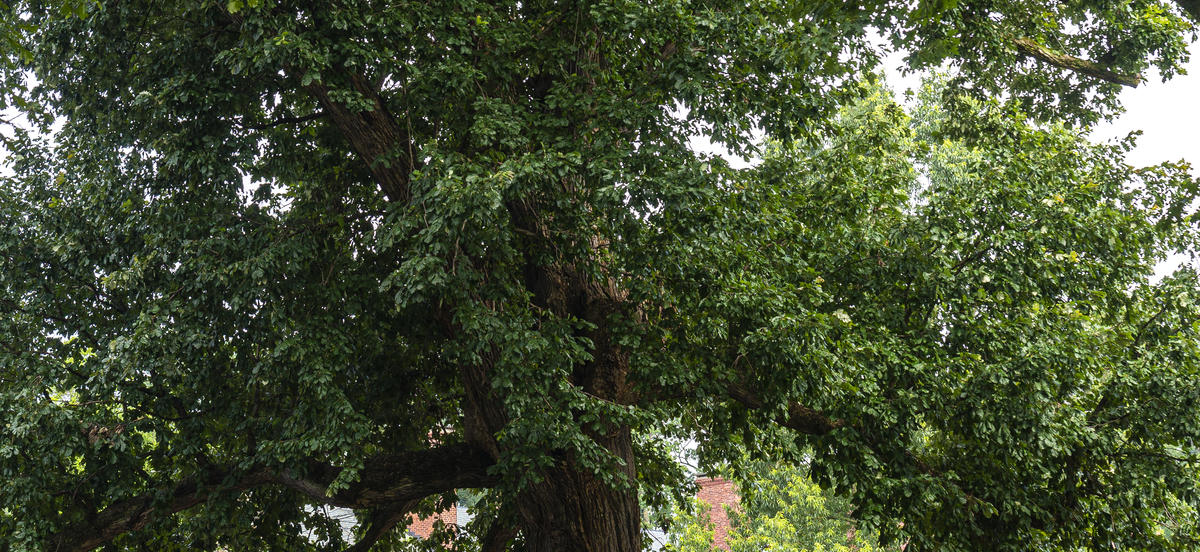Haverford College's Original Oaks

Haverford's original swamp white oak (Quercus bicolor). Photo: Patrick Montero.
Details
Some of Haverford's trees have been around since the founding of the campus. Learn more about these iconic Arboretum landmarks!
Reminders of Haverford's history exist throughout the campus. From Lutnick Library’s stone Carvill Arch of Haverford’s original greenhouse to the iconic and original Founders Hall, Haverford’s buildings echo with the footsteps of the students, staff, and faculty who came before us. While those who attended Haverford through the decades are long gone, these monuments to the original campus remain. One of the crucial witnesses to Haverford’s history are the trees. Thanks to original maps of campus from 1840 and beyond, we know that a select few of Haverford’s trees have been around almost as long as the campus has. Haverford has three trees from the original Arboretum plan created by William Carvill that still stand today.
One of these trees is the swamp white oak (Quercus bicolor) located between Founder’s Hall and Marshall Auditorium, on Lloyd Green. The other two are both bur oaks (Quercus macrocarpa), one standing next to Lutnick Library and the other between Founder’s Hall and Barclay Hall. Oaks, genus Quercus (KWER-kus), are in the beech or Fagaceae family, which includes oak, beech, and chestnut trees (Britannica). Oaks produce acorns, a favorite food of the Haverford squirrels. Oaks can be either deciduous or evergreen, meaning they may lose their leaves with the seasons or keep them year-round. Haverford’s oaks, however, are all deciduous. Oaks are common in North America, but may also be found in Europe and Asia.
The first of the oldest trees is the swamp white oak (Quercus bicolor) located between Marshall Auditorium and Founders Hall. This massive oak is surrounded by a fence, for the purpose of protecting both the viewer and the tree. The oak is getting on in years, making its roots and branches both delicate. The fence protects the roots of the tree, and prevents any branches from falling on unwitting tree admirers.
Swamp white oaks are indigenous to the East and Center of America’s Midwest, as well as parts of Canada. The swamp white oak is a deciduous tree, meaning it loses and grows new leaves with the changing seasons. Said leaves are dark green and white on the underside in the warm seasons, and become yellow or purple-red in the fall (Missouri Botanical Garden). They typically grow 50 to 60 feet tall, and can live for 300 years. Haverford’s swamp white oak is at least 189 years old. Haverford’s swamp white oak may be a favorite of the Duck Pond residents, seeing as the “swamp white oak acorns were found to make up 27 percent of the diet of wild ducks” (Rogers).
The first of Haverford’s 1834 bur oaks, or Quercus macrocarpa, is located next to the entrance to Lutnick Library, formerly known as Magill Library. The sloping ramp leading to the entrance intentionally curves around the tree. When the ramp was built in 1968, the architects intentionally built around the bur oak’s roots so as to preserve this historic part of campus (Van Artsdalen).
The bur oak, or Quercus macrocarpa, is indigenous to the North and Center of the Eastern United States, as well as Southeastern Canada. The bur oak is also commonly known as the mossycup oak. Both nicknames come from the appearance of the tree’s acorns, which “are covered with a mossy scale or bur near the rim” (Missouri Botanical Garden). It commonly reaches heights of 60 to 80 feet, but has been known to grow as tall as 150 feet (Arboretum Explorer). The deciduous bur oak’s dark leaves turn to a yellow-golden brown in the fall. The bur oak’s acorns feed red squirrels, wood ducks, and white-tailed deer (Johnson). The last of Haverford’s original trees is also a bur oak, planted near the swamp white oak on Lloyd Green. This tree is located between Founder’s Hall and Barclay Hall, two of the oldest buildings on campus.
Haverford College’s three original oaks are lesser-known landmarks of the campus. They have stood the test of time, watching the campus grow and change since its beginning. Haverford’s Arboretum has through the years become beloved by both the students, faculty, and staff, but also by the surrounding community. Hopefully, these trees will last for decades to come, continuing to watch over our campus.
References:
“Arboretum Explorer.” Haverford College Arboretum Arboretum Explorer, Haverford College Arboretum, 2023, https://haverford.arboretumexplorer.org/map.aspx.
Johnson, Paul S. “Quercus Macrocarpa Michx. Bur Oak.” USDA Forest Service Southern Research Station, United States Department of Agriculture, https://www.srs.fs.usda.gov/pubs/misc/ag_654/volume_2/quercus/macrocarpa.htm.
“Oak.” Britannica, Encyclopædia Britannica, Inc., 2023. www.britannica.com/plant/oak.
“Quercus Bicolor.” Missouri Botanical Garden Plant Finder, Missouri Botanical Garden, www.missouribotanicalgarden.org/PlantFinder/PlantFinderDetails.aspx?kempercode=q330.
“Quercus Macrocarpa.” Missouri Botanical Garden Plant Finder, Missouri Botanical Garden, https://www.missouribotanicalgarden.org/PlantFinder/PlantFinderDetails.aspx?kempercode=a902.
Roger, Roberts. “Quercus Bicolor Willd. Swamp White Oak.” USDA Forest Service Southern Research Station, United States Department of Agriculture, https://www.srs.fs.usda.gov/pubs/misc/ag_654/volume_2/quercus/bicolor.htm.
Van Artsdalen, Martha J. Images of America: Haverford College Arboretum. Arcadia Publishing: Charleston, South Carolina. 2016.




